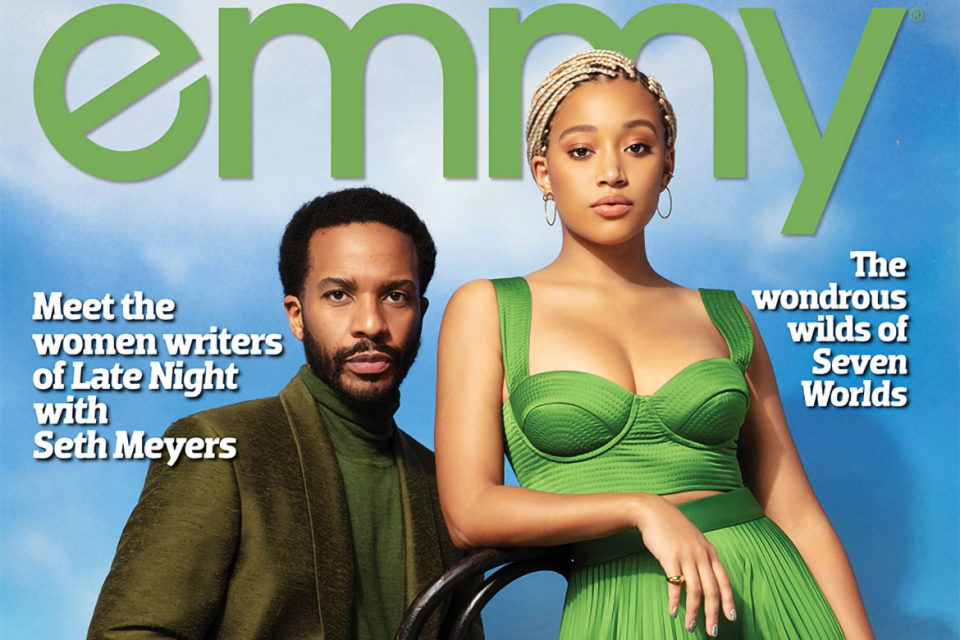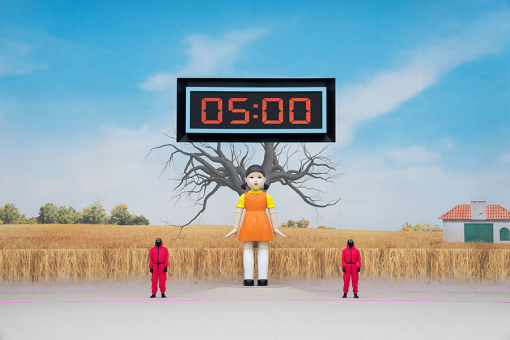As dusk turns to twilight, a street in Paris's 20th arrondissement comes alive.
It starts when five members of a jazz band appear at the end of the road, walking with their instruments and playing, as in a procession. Making their way past bistro diners seated three tables deep, they pick up the tempo.
Scooters buzz by as the singer croons, "Tonight, everybody's right," over a bossa nova bass line, and the accordionist maps out a lilting chord progression. The sky is a wistful blue, the aroma of frites is everywhere and the lime trees, strung with lightbulbs, seem to sway with the music.
"Just look at this," says executive producer Alan Poul, sitting at one of the tables. "Could it be any more Parisian?"
The producer-director (Six Feet Under, Tales of the City) is overseeing a closing scene from The Eddy, a Netflix drama that revolves around a struggling jazz club in contemporary Paris.
As the musicians round a corner, the handheld cameras stay with them, in the style executive producer Damien Chazelle (La La Land, First Man) established when he directed the first two episodes.
"Damien likes it super narrow," says Olivier Bibas, also an executive producer, along with Poul, Chazelle, Jack Thorne, Glen Ballard, Patrick Spence and Katie Swinden. "He loves corridors, alleyways, but the camera has to be free. Up, down, everywhere."
As the band flows down the street — led by André Holland (Moonlight, Castle Rock) as club owner–composer Elliot — the camera is indeed up, down, everywhere.
It settles for a while on the accordionist, played by acclaimed pianist-bandleader Randy Kerber, then goes low to look up at the band's singer, Maja, played by Joanna Kulig (Cold War). They run four or five takes, and each time, the music is different and the camera tries something new.
"Every day we come in, sometimes we work directly from the script, other days we improvise entire scenes," says Holland — who is also a coexecutive producer — as they reset for another take.
"To be honest, I don't actually know what we're going to do or how we're going to do it here. All I know is that this is some kind of a procession and we're all meant to be playing some music."
Later, Holland expands on the topic. "You get the sense on this show that everybody is doing something new. For example, the musicians are also acting, playing major parts. That's something they've not done before.
"I'm an actor, but I'm learning to play music. And I'm speaking French in the show, which is something I didn't do prior. Everyone is coming into this creative space having to do something new. So what you feel when you watch the music being performed is that sense of excitement. You don't know what's going to happen next."
That may sound like a risky way to make a television show, but improvisation is a large part of what The Eddy is all about. The show began with music, so melodies, rhythm and counterpoint run right through it.
"It started when Alan Poul approached me, right around the time that I was premiering Whiplash at Sundance [in 2014]," Chazelle says.
"He approached me with an idea that Glen Ballard had proposed to him, about a show set principally in a jazz club in contemporary Paris, and the lives of a hodgepodge of local expats as they struggle to keep the club afloat."
Ballard, a producer and composer who worked with Michael Jackson on Bad and cowrote Alanis Morrisette's Jagged Little Pill album, had already been working with a band he called The Eddy.
"The Eddy?" Ballard says, meaning his original concept. "It's a vortex of sound. It's a whirlpool. It seemed like the perfect metaphor for getting lost in something. Honestly, it's just been a love letter to jazz from me, as a composer and a lyricist."
Ballard had lived in Paris in the '90s, and in his mind, the City of Lights had to be the setting for his songs.
"Jazz has always found refuge here," he says. "There are 10 to 12 jazz clubs here all the time, and young people are listening to jazz. I thought, 'This is the only place to do it.' Every song that I wrote, all the lyrics that I've written are about this milieu, about being here in Paris right now."
So when Ballard went to Poul, he had not only a concept to pitch but fully recorded songs to play — and a gig-sharpened live band to go and watch.
"I went to see the band, and we were completely blown away," Poul says. "We were like, 'Okay. It's contemporary Paris, the other side of Paris. The 18th, 19th and 20th arrondissements. Nobody's ever seen this on American TV.'"
That's when Poul contacted Chazelle. Whiplash — another story of music and musicians — was gaining plaudits at Sundance and putting its writer- director on track to being Hollywood's Next Big Thing. It was two years before La La Land came out.
"I didn't know if it would work or not, but I knew that it personally resonated with me," says Chazelle, who was a jazz drummer before turning to film.
"Obviously there's the music element, but also I had experienced my own version of expat life in Paris. I grew up half-and-half — partly in Paris, partly in America with an American mother and a French father."
Chazelle wanted to examine a contemporary version of the French-American cultural dialogue, something more typically associated with the American jazz musicians who came to Paris in the 1940s, '50s and '60s. If he could find today's equivalent, he thought, he could offer a snapshot of the city itself.
"It was about trying to steer away from the picture-postcard version and look at the messy, complicated modern city. It felt like something that I could bring my personal experience to."
Writer-producer Jack Thorne (His Dark Materials and Broadway's Harry Potter and the Cursed Child) had already delved into the grittier side of contemporary Paris with his scripts for the SundanceTV 2013 miniseries The Last Panther.
"I was in L.A.," he recalls, "when my agent called me and said, 'There's this European project that I think you could be right for. Let me send you the film that the director has just made.' It was Whiplash. I sat in my hotel room going, 'Oh my God.'"
When Thorne met with Chazelle and Poul the next day, they talked about how to craft a piece that felt European, but more important, felt like it belonged in a specific part of Europe that hadn't been well documented. ...
For the rest of the story, pick up a copy of emmy magazine.
This article originally appeared in its entirety in emmy magazine, issue No. 4, 2020











